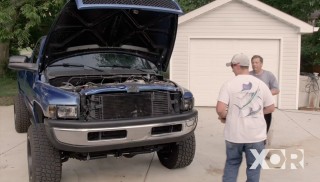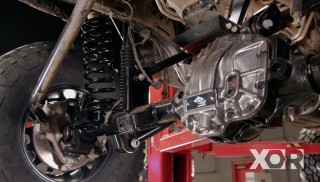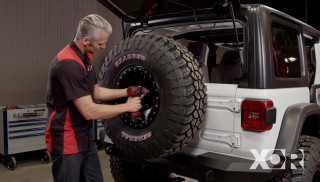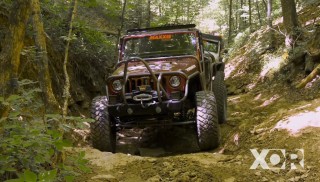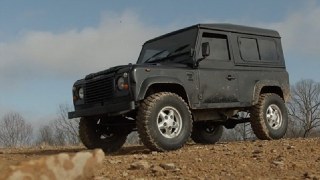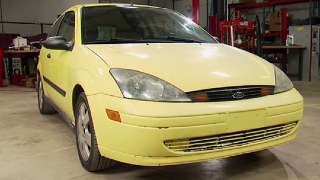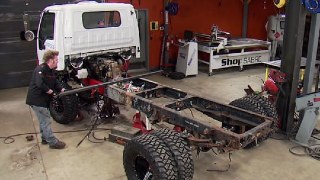XOR - Xtreme Off-Road Builds
Want more content like this?
Join the PowerNation Email NewsletterParts Used In This Episode
Lincoln Electric
Lincoln Electric is the official welding supplier to XOR
Matco Tools
MATCO Tools are the Official Tool Supplier to XOR
The Industrial Depot
Tools, Hardware, and Shop Supplies
Episode Transcript
(Narrator)>> Today we're building custom shock mounts for our Pre-Runner's long travel coil overs, and getting our fiberglass body sides installed. Then our fiberglass hood mounts go in place, and finally we're adding a long fuel filler neck to our fuel cell. It's all right here on XOR.
(Jeremy)>> Hey guys, welcome to XOR. Now we've made some pretty good progress on our 2002 Pre-Runner Ranger, and we've managed to install the entire pre-fabricated front suspension and a big coil over but unlike the front suspension we're gonna move on to the back and fabricate the entire rear mounts for these big bad shocks.
Now we went to Summit Racing dot com and picked up these completely adjustable shocks for the rear of the Ranger cause just like the front end the rear suspension is gonna take a beating and we're gonna want to adjust these so that they work absolutely great. So the first step to getting these installed is to build some cross bracing for our shock hoop. Our first tube comes in right in front of the down bars, and we're pulling a measurement from the front of the cab to make sure that this all stays square. Perfect! [ welder crackling ]
(Jeremy)>> And cross tube number two follows suit along with a measurement to make sure it all stays square. Make sure these are the same. [ welder crackling ] ♪ ♪
(Jeremy)>> I'm gonna want the shock to land somewhere between the two bars we just put on. So I'll go over the bender, bend the top loop so I can start building the top mount. Our Edwards tube bender is hydraulic but if you don't have a hydraulic tube bender a manual tube bender should give you the exact same results. Now the bend for our shock loop is gonna be pretty severe. So I don't want to waste a bunch of material by marking the bend line in the center of the tube. So I'm gonna mark my start line about eight inches from the end. Center this on the eight mark. ♪ ♪ Tighten the jam nut down. ♪ ♪ Fire it up! ♪ ♪ Do this is a couple of stages. I think I'm gonna shoot for about 125 to 130 degrees. ♪ ♪ There's 100, 110, 120, 125, 130! We'll start there. ♪ ♪ Notching is a big part of the fitment of your tubes. You want it to fit absolutely perfectly. That way you can come back and either mig weld it in or tig weld it in. We're just gonna mig weld it into place for now, and come back and tig weld it all in later. There's gonna be a lot of vertical force on our shock hoop. So we're gonna tie that into the main cage in just a couple of spots. ♪ ♪ One... ♪ ♪ [ welder crackling ] ♪ ♪
(Jeremy)>> Now we went ahead and bent up the passenger side shock hoop just like the driver's side. We're gonna use this side to help us make that the brackets that's gonna hold the top of the shock on, and there's no better tool to help us make that than cardboard. ♪ ♪ Now you know how we feel about using cardboard. Now this is a great tool to make your brackets because if you mess it up you can just throw it away and go grab another piece. Somewhere in there. And the cheapest part is you don't need any fancy tools to cut it out. ♪ ♪ That should sit somewhere right there. And after a lot of cutting and trimming this is the final piece. Now all we have to do is go make a bunch of these out of plate steel. We made these out of eighth inch plate steel. Cut one for both sides of the hoop, and now we're gonna bolt them on to the top of the shock. ♪ ♪ Now to keep both sides perfectly in line before I lay down my first tack I'm using two pieces of three quarter inch tubing. [ welder crackling ] ♪ ♪
(Jeremy)>> With the plate secured I'm gonna trim that same tube to weld in between the two plates, and this will add more strength to prevent twisting and bending, and it looks really cool. [ welder crackling ] ♪ ♪
(Narrator)>> Up next we get our fiberglass box sides installed, and later we'll install our extended fuel filler neck.
(Jeremy)>> Hey guys, welcome back to XOR. Well now that we have the rear shocks installed on the Ranger we're one step closer to the finish line, but this truck didn't always look like this. It started life as a stock 2002 two wheel drive Ford Ranger, and after we got rid of the entire front clip and took the bed off we got straight to work, but the next step is to make this truck look well like more of a truck again and that actually doesn't start here. It starts over on the bench. Now this is a fiberglass box side. Now these are commonly used on pre-runner trucks like our Ranger, on stadium trucks, and on trophy trucks. Now one of the big reasons why they run these is because it gets rid of all of the weight of the box that used to be sitting on your truck, and after a race they're easily replaceable but we've got to figure out how to get this onto our Ranger, and well that all starts with some flat strap. The strap we're using measures in at an eighth inch thick and about an inch and a half wide, and we're gonna have to shape this to fit. So I'm making reference marks so I can consistently check it in the same location once I have started making my bends. Even though it measures in at an eighth of an inch the strap is easily shaped by hand using a vice or by bending it over the edge of the table. That actually fits pretty good with a whole bunch of other bends in it. We'll mark the mounting holes on the piece and then go punch them out, and then we'll come back, mark those same holes on the fiberglass, and drill those out. So we don't splinter the fiberglass when we drill through it, put some tape on the bottom side.
When drilling through fiberglass spin the drill motor up as fast as it goes, but then just put really light pressure on it and let the drill bit cut through really easily. And for safety make sure you don't have your hand in the way on the other side as the drill bit comes through the fiberglass. Well now that we have the holes drilled we can go ahead and mount the flat strap. Now we're not just gonna use a regular bolt because the small diameter of the head will actually crack the fiberglass when we go to tighten it down. So we went to Summit Racing dot com and picked up some of their aluminum fender washers. Now with a larger head on this it's gonna disperse the load the load on the fiberglass so it doesn't crack and break. ♪ ♪ Moving to the back of the box side there's a perfectly flat surface. So I don't have to bend the plate at all. I can just drill some holes and bolt it in. Go punch those out. ♪ ♪ [ drill spinning ]
(Jeremy)>> And since these mounting points will not be seen we're just gonna go ahead and use some big fender washers to help disperse the load of the bolt. ♪ ♪ For now we're just gonna use regular nuts but for final installation we'll come back and replace all of those with nylon lock nuts. ♪ ♪ Now we'll set it up on the truck. Now I went down the hallway to Detroit Muscle and permanently borrowed one of their t-v light stands. Now this is completely adjustable. So when I go to set the box side on the truck I can adjust where it sits. Now you guys don't need a stolen t-v light stand. Just come up with something adjustable like a two by four and your floor jack. That way you can hold your panel perfectly in place.
Now you're looking through the cage at the inside of our fiberglass panel. We're gonna take some measurements, use some three quarter inch square tubing, and tack it on to the flat strap. And now we're gonna do the exact same thing on the back but I'm making really quick tacks cause I don't want to bubble the paint on our freshly painted box sides. [ welder crackling ] ♪ ♪
(Jeremy)>> Now you can use square tubing, or you can use round tubing, or you can use whatever you have in your shop. Just make sure it's strong enough to support all of those G-forces banging around on your fenders. [ welder crackling ]
(Jeremy)>> This shot clearly shows the mounted fiberglass. Now all I've got to do is remove the box side and weld it all in, and the real test. ♪ ♪ Perfect!
(Narrator)>> When we come back we're getting our fiberglass hood secured in place, stay tuned!
(Jeremy)>> Hey guys, welcome back to XOR. Well now that we have the rear box sides on our Ranger it's time to move on to the front and put the hood on, and this is gonna be the same song just the second verse. But unlike in the back, how we built the mounts on the fiberglass and then brought those to the cage, on the front we're gonna build mounts on the cage and bring those towards the fiberglass. To mount the fiberglass up front we're gonna be using round tubing instead of square tubing, but just like in the rear we're gonna be using the same flat stock. ♪ ♪ Piece number one. Weasel my way in here. We're gonna use a piece of tubing we used to make our roll cage as a stand, and then a piece of flat strap we used in the back. [ welder crackling ]
(Jeremy)>> And here's a little tip. If you can't get in here to drill the holes perfectly because the bar's in the way we'll use a small drill bit and drill a pilot hole, and then I'll go around on the top side and drill through. Now when working underneath projects don't forget to always wear your safety gear, and especially when you're working with fiberglass. Fiberglass has a tendency of getting all over you, underneath your skin, and the last place you want it is in your eyes. [ drill spinning ] ♪ ♪
(Jeremy)>> For now, to bolt everything together, we're just gonna be using regular nuts but we have something special in store. ♪ ♪ I'm gonna add three quarter inch square tubing to add one brace out to the fender. [ welder crackling ]
(Jeremy)>> There we go. Now as tricky as it is getting in and out of here the back mount's gonna be exactly the same as the front mount. We're just gonna use a piece of tubing and some flat plate. Now this should be plenty strong and make it pretty easy to get the hood on and off. ♪ ♪ The special trick we have for installing the hood is we're gonna be removing the regular nuts and welding on some flange nuts. That way we don't have to hold the bottom side as we're tightening down the top side. [ welder crackling ] ♪ ♪
(Jeremy)>> When you're using this technique make sure you remov4e the bolts right away because the heat transfer may actually lock that bolt in place.
(Narrator)>> After the break we'll get our longer fuel filler neck installed, stick around!
(Jeremy)>> Hey guys, with our spare tires in place we kind of run into another issue. Our fuel cell is way down there beneath both of our spare tires. We've got to come up with a way to get fuel from out here down there, and believe it or not we have a solution. Now we went to Summit Racing dot com and got everything we need to pull this off. This is an adapter to go on the top of our fuel cell, and this is their fender fill kit. It's got everything we need to connect our fuel filler to the top of our fuel cell, and it even comes with an extension for your rollover valve. First step is to remove the original fuel cell filler cap. ♪ ♪ And this adapter is made to go right on top of the fuel cell. ♪ ♪ Now we'll length here. The filler neck needs to be trimmed just a little bit, and here's a tip. Wrap tape around the neck, trim along the edge of the tape, and you'll have a nice, straight cut. Now we need to find a way to attach this to the cage of our pre-runner. Well this is what we came up with. After spending some time with good ole fashioned cardboard we'll trace this out on some eighth inch plate steel. After a quick cut with the plasma cutter and a quick trip to the iron worker we're gonna have a bracket that will secure this to the back of the cage. ♪ ♪ We're using our Lincoln Electric Tomahawk 1,000 plasma cutter. It cuts through eighth inch plate steel like butter. ♪ ♪ [ grinding metal ]
(Jeremy)>> Up next is our cordless Matco grinder with a four inch flap disc. [ grinding metal ]
(Jeremy)>> I use the filler neck adapter to mark the holes out on the piece. Now we're just gonna use the Edwards iron worker to punch the holes out. ♪ ♪ Center the tube to the edge of the brackets, about two and seven-eighths. For more information on anything on today's show go to Powernation TV dot com. ♪ ♪ And last but not least is the extension for the roll over valve. We'll put this somewhere towards the back and put a little breather on it. That way if we roll over we won't spill fuel. ♪ ♪ For those of you guys out there that have older vehicles, well the door may sag a little bit when you open it. Well the most common cause of that is a set of worn out door hinge pins and bushings. Well we're gonna show you an affordable way that won't take you too long to get that door right back where it should be. Now our top hinge doesn't have any movement in it, and our bottom hinge has a little bit of movement here, but that little bit of movement on the front side of the door amplified over the length of the door is a lot of movement out here. So the way to fix that is to go to your local parts store and pick up a set of door hinge pin and bushings. And then all you've got to do is put what's in here in here. ♪ ♪ The first step on our Ranger is to drill out and grind off the top of our pin. ♪ ♪ Sometimes these are not pressed in. So it's worth giving them a twist, but this one obviously is. So now we've got to try to drive the pin out. ♪ ♪ Now here's the parts that wear out. Inside your door hinge are a set of brass bushings, and after years and years of opening and closing your door those bushings wear out, allowing your pin to move around and that allows your door to move around. Using a punch and a chisel, collapse the sides of the bushing and then just pound them out. Well that was easy. In some kits they send oversized bushings. So you may need to drill out your hinge. With the soft brass bushing in place top it with a steel washer. That way you won't distort it as you're pressing it in. And it's the exact same procedure for the bottom bushing. ♪ ♪ Now the new pin is knurled. So it takes a little bit of persuasion to get it in place. [ hammer tapping ] And with one last piece your door hinge assembly is put back together. And with a little bit of time and a Sunday afternoon, and a trip to the auto parts store, you can put your door right back where it should but just one word of advice. Take the door off when you do this. It makes your life a whole lot easier.
Show Full Transcript
(Jeremy)>> Hey guys, welcome to XOR. Now we've made some pretty good progress on our 2002 Pre-Runner Ranger, and we've managed to install the entire pre-fabricated front suspension and a big coil over but unlike the front suspension we're gonna move on to the back and fabricate the entire rear mounts for these big bad shocks.
Now we went to Summit Racing dot com and picked up these completely adjustable shocks for the rear of the Ranger cause just like the front end the rear suspension is gonna take a beating and we're gonna want to adjust these so that they work absolutely great. So the first step to getting these installed is to build some cross bracing for our shock hoop. Our first tube comes in right in front of the down bars, and we're pulling a measurement from the front of the cab to make sure that this all stays square. Perfect! [ welder crackling ]
(Jeremy)>> And cross tube number two follows suit along with a measurement to make sure it all stays square. Make sure these are the same. [ welder crackling ] ♪ ♪
(Jeremy)>> I'm gonna want the shock to land somewhere between the two bars we just put on. So I'll go over the bender, bend the top loop so I can start building the top mount. Our Edwards tube bender is hydraulic but if you don't have a hydraulic tube bender a manual tube bender should give you the exact same results. Now the bend for our shock loop is gonna be pretty severe. So I don't want to waste a bunch of material by marking the bend line in the center of the tube. So I'm gonna mark my start line about eight inches from the end. Center this on the eight mark. ♪ ♪ Tighten the jam nut down. ♪ ♪ Fire it up! ♪ ♪ Do this is a couple of stages. I think I'm gonna shoot for about 125 to 130 degrees. ♪ ♪ There's 100, 110, 120, 125, 130! We'll start there. ♪ ♪ Notching is a big part of the fitment of your tubes. You want it to fit absolutely perfectly. That way you can come back and either mig weld it in or tig weld it in. We're just gonna mig weld it into place for now, and come back and tig weld it all in later. There's gonna be a lot of vertical force on our shock hoop. So we're gonna tie that into the main cage in just a couple of spots. ♪ ♪ One... ♪ ♪ [ welder crackling ] ♪ ♪
(Jeremy)>> Now we went ahead and bent up the passenger side shock hoop just like the driver's side. We're gonna use this side to help us make that the brackets that's gonna hold the top of the shock on, and there's no better tool to help us make that than cardboard. ♪ ♪ Now you know how we feel about using cardboard. Now this is a great tool to make your brackets because if you mess it up you can just throw it away and go grab another piece. Somewhere in there. And the cheapest part is you don't need any fancy tools to cut it out. ♪ ♪ That should sit somewhere right there. And after a lot of cutting and trimming this is the final piece. Now all we have to do is go make a bunch of these out of plate steel. We made these out of eighth inch plate steel. Cut one for both sides of the hoop, and now we're gonna bolt them on to the top of the shock. ♪ ♪ Now to keep both sides perfectly in line before I lay down my first tack I'm using two pieces of three quarter inch tubing. [ welder crackling ] ♪ ♪
(Jeremy)>> With the plate secured I'm gonna trim that same tube to weld in between the two plates, and this will add more strength to prevent twisting and bending, and it looks really cool. [ welder crackling ] ♪ ♪
(Narrator)>> Up next we get our fiberglass box sides installed, and later we'll install our extended fuel filler neck.
(Jeremy)>> Hey guys, welcome back to XOR. Well now that we have the rear shocks installed on the Ranger we're one step closer to the finish line, but this truck didn't always look like this. It started life as a stock 2002 two wheel drive Ford Ranger, and after we got rid of the entire front clip and took the bed off we got straight to work, but the next step is to make this truck look well like more of a truck again and that actually doesn't start here. It starts over on the bench. Now this is a fiberglass box side. Now these are commonly used on pre-runner trucks like our Ranger, on stadium trucks, and on trophy trucks. Now one of the big reasons why they run these is because it gets rid of all of the weight of the box that used to be sitting on your truck, and after a race they're easily replaceable but we've got to figure out how to get this onto our Ranger, and well that all starts with some flat strap. The strap we're using measures in at an eighth inch thick and about an inch and a half wide, and we're gonna have to shape this to fit. So I'm making reference marks so I can consistently check it in the same location once I have started making my bends. Even though it measures in at an eighth of an inch the strap is easily shaped by hand using a vice or by bending it over the edge of the table. That actually fits pretty good with a whole bunch of other bends in it. We'll mark the mounting holes on the piece and then go punch them out, and then we'll come back, mark those same holes on the fiberglass, and drill those out. So we don't splinter the fiberglass when we drill through it, put some tape on the bottom side.
When drilling through fiberglass spin the drill motor up as fast as it goes, but then just put really light pressure on it and let the drill bit cut through really easily. And for safety make sure you don't have your hand in the way on the other side as the drill bit comes through the fiberglass. Well now that we have the holes drilled we can go ahead and mount the flat strap. Now we're not just gonna use a regular bolt because the small diameter of the head will actually crack the fiberglass when we go to tighten it down. So we went to Summit Racing dot com and picked up some of their aluminum fender washers. Now with a larger head on this it's gonna disperse the load the load on the fiberglass so it doesn't crack and break. ♪ ♪ Moving to the back of the box side there's a perfectly flat surface. So I don't have to bend the plate at all. I can just drill some holes and bolt it in. Go punch those out. ♪ ♪ [ drill spinning ]
(Jeremy)>> And since these mounting points will not be seen we're just gonna go ahead and use some big fender washers to help disperse the load of the bolt. ♪ ♪ For now we're just gonna use regular nuts but for final installation we'll come back and replace all of those with nylon lock nuts. ♪ ♪ Now we'll set it up on the truck. Now I went down the hallway to Detroit Muscle and permanently borrowed one of their t-v light stands. Now this is completely adjustable. So when I go to set the box side on the truck I can adjust where it sits. Now you guys don't need a stolen t-v light stand. Just come up with something adjustable like a two by four and your floor jack. That way you can hold your panel perfectly in place.
Now you're looking through the cage at the inside of our fiberglass panel. We're gonna take some measurements, use some three quarter inch square tubing, and tack it on to the flat strap. And now we're gonna do the exact same thing on the back but I'm making really quick tacks cause I don't want to bubble the paint on our freshly painted box sides. [ welder crackling ] ♪ ♪
(Jeremy)>> Now you can use square tubing, or you can use round tubing, or you can use whatever you have in your shop. Just make sure it's strong enough to support all of those G-forces banging around on your fenders. [ welder crackling ]
(Jeremy)>> This shot clearly shows the mounted fiberglass. Now all I've got to do is remove the box side and weld it all in, and the real test. ♪ ♪ Perfect!
(Narrator)>> When we come back we're getting our fiberglass hood secured in place, stay tuned!
(Jeremy)>> Hey guys, welcome back to XOR. Well now that we have the rear box sides on our Ranger it's time to move on to the front and put the hood on, and this is gonna be the same song just the second verse. But unlike in the back, how we built the mounts on the fiberglass and then brought those to the cage, on the front we're gonna build mounts on the cage and bring those towards the fiberglass. To mount the fiberglass up front we're gonna be using round tubing instead of square tubing, but just like in the rear we're gonna be using the same flat stock. ♪ ♪ Piece number one. Weasel my way in here. We're gonna use a piece of tubing we used to make our roll cage as a stand, and then a piece of flat strap we used in the back. [ welder crackling ]
(Jeremy)>> And here's a little tip. If you can't get in here to drill the holes perfectly because the bar's in the way we'll use a small drill bit and drill a pilot hole, and then I'll go around on the top side and drill through. Now when working underneath projects don't forget to always wear your safety gear, and especially when you're working with fiberglass. Fiberglass has a tendency of getting all over you, underneath your skin, and the last place you want it is in your eyes. [ drill spinning ] ♪ ♪
(Jeremy)>> For now, to bolt everything together, we're just gonna be using regular nuts but we have something special in store. ♪ ♪ I'm gonna add three quarter inch square tubing to add one brace out to the fender. [ welder crackling ]
(Jeremy)>> There we go. Now as tricky as it is getting in and out of here the back mount's gonna be exactly the same as the front mount. We're just gonna use a piece of tubing and some flat plate. Now this should be plenty strong and make it pretty easy to get the hood on and off. ♪ ♪ The special trick we have for installing the hood is we're gonna be removing the regular nuts and welding on some flange nuts. That way we don't have to hold the bottom side as we're tightening down the top side. [ welder crackling ] ♪ ♪
(Jeremy)>> When you're using this technique make sure you remov4e the bolts right away because the heat transfer may actually lock that bolt in place.
(Narrator)>> After the break we'll get our longer fuel filler neck installed, stick around!
(Jeremy)>> Hey guys, with our spare tires in place we kind of run into another issue. Our fuel cell is way down there beneath both of our spare tires. We've got to come up with a way to get fuel from out here down there, and believe it or not we have a solution. Now we went to Summit Racing dot com and got everything we need to pull this off. This is an adapter to go on the top of our fuel cell, and this is their fender fill kit. It's got everything we need to connect our fuel filler to the top of our fuel cell, and it even comes with an extension for your rollover valve. First step is to remove the original fuel cell filler cap. ♪ ♪ And this adapter is made to go right on top of the fuel cell. ♪ ♪ Now we'll length here. The filler neck needs to be trimmed just a little bit, and here's a tip. Wrap tape around the neck, trim along the edge of the tape, and you'll have a nice, straight cut. Now we need to find a way to attach this to the cage of our pre-runner. Well this is what we came up with. After spending some time with good ole fashioned cardboard we'll trace this out on some eighth inch plate steel. After a quick cut with the plasma cutter and a quick trip to the iron worker we're gonna have a bracket that will secure this to the back of the cage. ♪ ♪ We're using our Lincoln Electric Tomahawk 1,000 plasma cutter. It cuts through eighth inch plate steel like butter. ♪ ♪ [ grinding metal ]
(Jeremy)>> Up next is our cordless Matco grinder with a four inch flap disc. [ grinding metal ]
(Jeremy)>> I use the filler neck adapter to mark the holes out on the piece. Now we're just gonna use the Edwards iron worker to punch the holes out. ♪ ♪ Center the tube to the edge of the brackets, about two and seven-eighths. For more information on anything on today's show go to Powernation TV dot com. ♪ ♪ And last but not least is the extension for the roll over valve. We'll put this somewhere towards the back and put a little breather on it. That way if we roll over we won't spill fuel. ♪ ♪ For those of you guys out there that have older vehicles, well the door may sag a little bit when you open it. Well the most common cause of that is a set of worn out door hinge pins and bushings. Well we're gonna show you an affordable way that won't take you too long to get that door right back where it should be. Now our top hinge doesn't have any movement in it, and our bottom hinge has a little bit of movement here, but that little bit of movement on the front side of the door amplified over the length of the door is a lot of movement out here. So the way to fix that is to go to your local parts store and pick up a set of door hinge pin and bushings. And then all you've got to do is put what's in here in here. ♪ ♪ The first step on our Ranger is to drill out and grind off the top of our pin. ♪ ♪ Sometimes these are not pressed in. So it's worth giving them a twist, but this one obviously is. So now we've got to try to drive the pin out. ♪ ♪ Now here's the parts that wear out. Inside your door hinge are a set of brass bushings, and after years and years of opening and closing your door those bushings wear out, allowing your pin to move around and that allows your door to move around. Using a punch and a chisel, collapse the sides of the bushing and then just pound them out. Well that was easy. In some kits they send oversized bushings. So you may need to drill out your hinge. With the soft brass bushing in place top it with a steel washer. That way you won't distort it as you're pressing it in. And it's the exact same procedure for the bottom bushing. ♪ ♪ Now the new pin is knurled. So it takes a little bit of persuasion to get it in place. [ hammer tapping ] And with one last piece your door hinge assembly is put back together. And with a little bit of time and a Sunday afternoon, and a trip to the auto parts store, you can put your door right back where it should but just one word of advice. Take the door off when you do this. It makes your life a whole lot easier.


